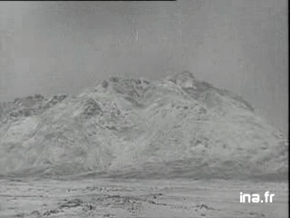Agathe (atomic test)
Agathe (aka Agate) was the name of the first French nuclear underground test. It was an atomic bomb detonated in the Hoggar mount (near In Ekker) of the then French Sahara desert on November 21, 1961, during the Algerian War (1954–62).[1]
Agathe was the first test of the jewel designation series running from 1961 until 1966. Minor and major incidents occurred during these experiments, the most important being the Beryl incident on May 1, 1962 where the nine militarymen of the 621ème Groupe d'Armes Spéciales unit were heavily contaminated (600 mSv) as portrayed in the 2006 docudrama Vive La Bombe!. The French Defence Minister Pierre Messmer and other officials and civilians were present in the command post and were contaminated too (around >200 mSv).
Specifics
- Time: 21 November 1961 (GMT)
- Location: Hoggar mount (near In Ekker)
- Yield: <20 kt
Programme

- 1961-11-07: Agathe (Agate): <20 kt
- 1962-05-01: Béryl (Beryl): <30 kt
- 1963-03-18: Émeraude (Emerald): <20 kt
- 1963-03-30: Améthyste (Amethyst): <5 kt
- 1963-10-20: Rubis (Ruby): <100 kt
- 1964-02-14: Opale (Opal): <5 kt
- 1964-06-15: Topaze (Topaz): <5 kt
- 1964-11-28: Turquoise (Turquoise): <20 kt
- 1965-02-27: Saphir (Sapphire): <150 kt
- 1965-05-30: Jade (Jade): <5 kt
- 1965-10-01: Corindon (Corundum): <5 kt
- 1965-12-01: Tourmaline (Tourmaline): <20 kt
- 1966-02-16: Grenat (Garnet): <20 kt
Known incidents
The millisievert (mSv) is commonly used to measure the effective dose in diagnostic medical procedures. See radiation poisoning for a more complete analysis of effects of various dosage levels.
- 1962-05-01: Béryl casualties
- 100 pers. (>50 mSv)
- 15 pers. (>200 mSv)
- 9 pers. (600 mSv)
- possibly 240 pers. (<2.5 mSv)
- 1963-03-30: Améthyste casualties
- 13 pers. (=10 mSv)
- 280 pers. (<1 mSv)
- 1963-10-20: Rubis casualties
- 500 pers. (<0.2 mSv)
- undisclosed (= 0.01 mSv)
- 1965-05-30 Jade casualties:
- undisclosed (<1 mSv)
Data provided by the French Defense Ministry on January 2007.[2]
See also
- Gerboise Bleue (French A-bomb)
- Canopus (French H-bomb)
- Force de frappe
- Nuclear weapons and France
- List of states with nuclear weapons